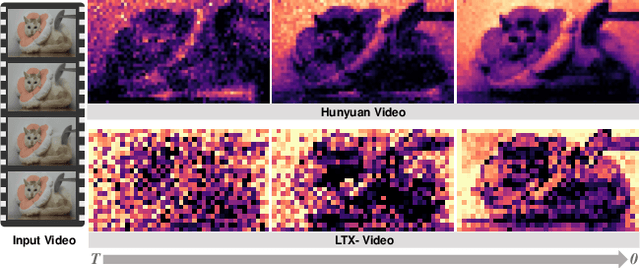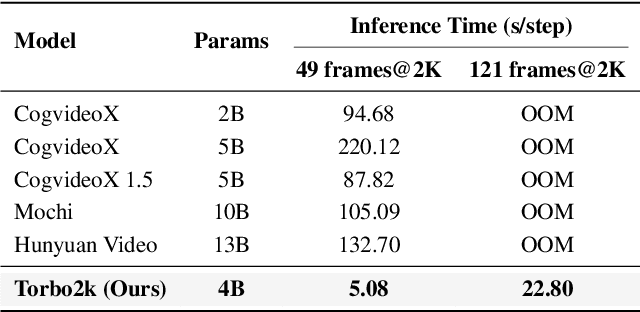Haoze Sun
S2SBench: A Benchmark for Quantifying Intelligence Degradation in Speech-to-Speech Large Language Models
May 20, 2025Abstract:End-to-end speech large language models ((LLMs)) extend the capabilities of text-based models to directly process and generate audio tokens. However, this often leads to a decline in reasoning and generation performance compared to text input, a phenomenon referred to as intelligence degradation. To systematically evaluate this gap, we propose S2SBench, a benchmark designed to quantify performance degradation in Speech LLMs. It includes diagnostic datasets targeting sentence continuation and commonsense reasoning under audio input. We further introduce a pairwise evaluation protocol based on perplexity differences between plausible and implausible samples to measure degradation relative to text input. We apply S2SBench to analyze the training process of Baichuan-Audio, which further demonstrates the benchmark's effectiveness. All datasets and evaluation code are available at https://github.com/undobug/S2SBench.
Turbo2K: Towards Ultra-Efficient and High-Quality 2K Video Synthesis
Apr 20, 2025



Abstract:Demand for 2K video synthesis is rising with increasing consumer expectations for ultra-clear visuals. While diffusion transformers (DiTs) have demonstrated remarkable capabilities in high-quality video generation, scaling them to 2K resolution remains computationally prohibitive due to quadratic growth in memory and processing costs. In this work, we propose Turbo2K, an efficient and practical framework for generating detail-rich 2K videos while significantly improving training and inference efficiency. First, Turbo2K operates in a highly compressed latent space, reducing computational complexity and memory footprint, making high-resolution video synthesis feasible. However, the high compression ratio of the VAE and limited model size impose constraints on generative quality. To mitigate this, we introduce a knowledge distillation strategy that enables a smaller student model to inherit the generative capacity of a larger, more powerful teacher model. Our analysis reveals that, despite differences in latent spaces and architectures, DiTs exhibit structural similarities in their internal representations, facilitating effective knowledge transfer. Second, we design a hierarchical two-stage synthesis framework that first generates multi-level feature at lower resolutions before guiding high-resolution video generation. This approach ensures structural coherence and fine-grained detail refinement while eliminating redundant encoding-decoding overhead, further enhancing computational efficiency.Turbo2K achieves state-of-the-art efficiency, generating 5-second, 24fps, 2K videos with significantly reduced computational cost. Compared to existing methods, Turbo2K is up to 20$\times$ faster for inference, making high-resolution video generation more scalable and practical for real-world applications.
ReSearch: Learning to Reason with Search for LLMs via Reinforcement Learning
Mar 27, 2025



Abstract:Large Language Models (LLMs) have shown remarkable capabilities in reasoning, exemplified by the success of OpenAI-o1 and DeepSeek-R1. However, integrating reasoning with external search processes remains challenging, especially for complex multi-hop questions requiring multiple retrieval steps. We propose ReSearch, a novel framework that trains LLMs to Reason with Search via reinforcement learning without using any supervised data on reasoning steps. Our approach treats search operations as integral components of the reasoning chain, where when and how to perform searches is guided by text-based thinking, and search results subsequently influence further reasoning. We train ReSearch on Qwen2.5-7B(-Instruct) and Qwen2.5-32B(-Instruct) models and conduct extensive experiments. Despite being trained on only one dataset, our models demonstrate strong generalizability across various benchmarks. Analysis reveals that ReSearch naturally elicits advanced reasoning capabilities such as reflection and self-correction during the reinforcement learning process.
DualToken: Towards Unifying Visual Understanding and Generation with Dual Visual Vocabularies
Mar 19, 2025Abstract:The differing representation spaces required for visual understanding and generation pose a challenge in unifying them within the autoregressive paradigm of large language models. A vision tokenizer trained for reconstruction excels at capturing low-level perceptual details, making it well-suited for visual generation but lacking high-level semantic representations for understanding tasks. Conversely, a vision encoder trained via contrastive learning aligns well with language but struggles to decode back into the pixel space for generation tasks. To bridge this gap, we propose DualToken, a method that unifies representations for both understanding and generation within a single tokenizer. However, directly integrating reconstruction and semantic objectives in a single tokenizer creates conflicts, leading to degraded performance in both reconstruction quality and semantic performance. Instead of forcing a single codebook to handle both semantic and perceptual information, DualToken disentangles them by introducing separate codebooks for high and low-level features, effectively transforming their inherent conflict into a synergistic relationship. As a result, DualToken achieves state-of-the-art performance in both reconstruction and semantic tasks while demonstrating remarkable effectiveness in downstream MLLM understanding and generation tasks. Notably, we also show that DualToken, as a unified tokenizer, surpasses the naive combination of two distinct types vision encoders, providing superior performance within a unified MLLM.
Pixel to Gaussian: Ultra-Fast Continuous Super-Resolution with 2D Gaussian Modeling
Mar 09, 2025Abstract:Arbitrary-scale super-resolution (ASSR) aims to reconstruct high-resolution (HR) images from low-resolution (LR) inputs with arbitrary upsampling factors using a single model, addressing the limitations of traditional SR methods constrained to fixed-scale factors (\textit{e.g.}, $\times$ 2). Recent advances leveraging implicit neural representation (INR) have achieved great progress by modeling coordinate-to-pixel mappings. However, the efficiency of these methods may suffer from repeated upsampling and decoding, while their reconstruction fidelity and quality are constrained by the intrinsic representational limitations of coordinate-based functions. To address these challenges, we propose a novel ContinuousSR framework with a Pixel-to-Gaussian paradigm, which explicitly reconstructs 2D continuous HR signals from LR images using Gaussian Splatting. This approach eliminates the need for time-consuming upsampling and decoding, enabling extremely fast arbitrary-scale super-resolution. Once the Gaussian field is built in a single pass, ContinuousSR can perform arbitrary-scale rendering in just 1ms per scale. Our method introduces several key innovations. Through statistical ana
Baichuan-Audio: A Unified Framework for End-to-End Speech Interaction
Feb 24, 2025Abstract:We introduce Baichuan-Audio, an end-to-end audio large language model that seamlessly integrates audio understanding and generation. It features a text-guided aligned speech generation mechanism, enabling real-time speech interaction with both comprehension and generation capabilities. Baichuan-Audio leverages a pre-trained ASR model, followed by multi-codebook discretization of speech at a frame rate of 12.5 Hz. This multi-codebook setup ensures that speech tokens retain both semantic and acoustic information. To further enhance modeling, an independent audio head is employed to process audio tokens, effectively capturing their unique characteristics. To mitigate the loss of intelligence during pre-training and preserve the original capabilities of the LLM, we propose a two-stage pre-training strategy that maintains language understanding while enhancing audio modeling. Following alignment, the model excels in real-time speech-based conversation and exhibits outstanding question-answering capabilities, demonstrating its versatility and efficiency. The proposed model demonstrates superior performance in real-time spoken dialogue and exhibits strong question-answering abilities. Our code, model and training data are available at https://github.com/baichuan-inc/Baichuan-Audio
Baichuan-Omni-1.5 Technical Report
Jan 26, 2025Abstract:We introduce Baichuan-Omni-1.5, an omni-modal model that not only has omni-modal understanding capabilities but also provides end-to-end audio generation capabilities. To achieve fluent and high-quality interaction across modalities without compromising the capabilities of any modality, we prioritized optimizing three key aspects. First, we establish a comprehensive data cleaning and synthesis pipeline for multimodal data, obtaining about 500B high-quality data (text, audio, and vision). Second, an audio-tokenizer (Baichuan-Audio-Tokenizer) has been designed to capture both semantic and acoustic information from audio, enabling seamless integration and enhanced compatibility with MLLM. Lastly, we designed a multi-stage training strategy that progressively integrates multimodal alignment and multitask fine-tuning, ensuring effective synergy across all modalities. Baichuan-Omni-1.5 leads contemporary models (including GPT4o-mini and MiniCPM-o 2.6) in terms of comprehensive omni-modal capabilities. Notably, it achieves results comparable to leading models such as Qwen2-VL-72B across various multimodal medical benchmarks.
Beyond Pixels: Text Enhances Generalization in Real-World Image Restoration
Dec 01, 2024



Abstract:Generalization has long been a central challenge in real-world image restoration. While recent diffusion-based restoration methods, which leverage generative priors from text-to-image models, have made progress in recovering more realistic details, they still encounter "generative capability deactivation" when applied to out-of-distribution real-world data. To address this, we propose using text as an auxiliary invariant representation to reactivate the generative capabilities of these models. We begin by identifying two key properties of text input: richness and relevance, and examine their respective influence on model performance. Building on these insights, we introduce Res-Captioner, a module that generates enhanced textual descriptions tailored to image content and degradation levels, effectively mitigating response failures. Additionally, we present RealIR, a new benchmark designed to capture diverse real-world scenarios. Extensive experiments demonstrate that Res-Captioner significantly enhances the generalization abilities of diffusion-based restoration models, while remaining fully plug-and-play.
Unveiling Hidden Details: A RAW Data-Enhanced Paradigm for Real-World Super-Resolution
Nov 21, 2024



Abstract:Real-world image super-resolution (Real SR) aims to generate high-fidelity, detail-rich high-resolution (HR) images from low-resolution (LR) counterparts. Existing Real SR methods primarily focus on generating details from the LR RGB domain, often leading to a lack of richness or fidelity in fine details. In this paper, we pioneer the use of details hidden in RAW data to complement existing RGB-only methods, yielding superior outputs. We argue that key image processing steps in Image Signal Processing, such as denoising and demosaicing, inherently result in the loss of fine details in LR images, making LR RAW a valuable information source. To validate this, we present RealSR-RAW, a comprehensive dataset comprising over 10,000 pairs with LR and HR RGB images, along with corresponding LR RAW, captured across multiple smartphones under varying focal lengths and diverse scenes. Additionally, we propose a novel, general RAW adapter to efficiently integrate LR RAW data into existing CNNs, Transformers, and Diffusion-based Real SR models by suppressing the noise contained in LR RAW and aligning its distribution. Extensive experiments demonstrate that incorporating RAW data significantly enhances detail recovery and improves Real SR performance across ten evaluation metrics, including both fidelity and perception-oriented metrics. Our findings open a new direction for the Real SR task, with the dataset and code will be made available to support future research.
Baichuan Alignment Technical Report
Oct 19, 2024



Abstract:We introduce Baichuan Alignment, a detailed analysis of the alignment techniques employed in the Baichuan series of models. This represents the industry's first comprehensive account of alignment methodologies, offering valuable insights for advancing AI research. We investigate the critical components that enhance model performance during the alignment process, including optimization methods, data strategies, capability enhancements, and evaluation processes. The process spans three key stages: Prompt Augmentation System (PAS), Supervised Fine-Tuning (SFT), and Preference Alignment. The problems encountered, the solutions applied, and the improvements made are thoroughly recorded. Through comparisons across well-established benchmarks, we highlight the technological advancements enabled by Baichuan Alignment. Baichuan-Instruct is an internal model, while Qwen2-Nova-72B and Llama3-PBM-Nova-70B are instruct versions of the Qwen2-72B and Llama-3-70B base models, optimized through Baichuan Alignment. Baichuan-Instruct demonstrates significant improvements in core capabilities, with user experience gains ranging from 17% to 28%, and performs exceptionally well on specialized benchmarks. In open-source benchmark evaluations, both Qwen2-Nova-72B and Llama3-PBM-Nova-70B consistently outperform their respective official instruct versions across nearly all datasets. This report aims to clarify the key technologies behind the alignment process, fostering a deeper understanding within the community. Llama3-PBM-Nova-70B model is available at https://huggingface.co/PKU-Baichuan-MLSystemLab/Llama3-PBM-Nova-70B.
 Add to Chrome
Add to Chrome Add to Firefox
Add to Firefox Add to Edge
Add to Edge